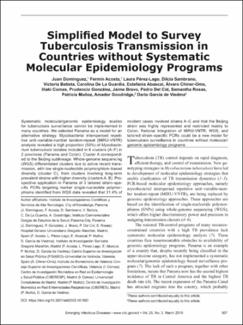Mostrar el registro sencillo del ítem
Simplified Model to Survey Tuberculosis Transmission in Countries Without Systematic Molecular Epidemiology Programs
| dc.creator | Domínguez, Juan | |
| dc.creator | Acosta, Fermín | |
| dc.creator | Pérez-Lago, Laura | |
| dc.creator | Sambrano, Dilcia | |
| dc.creator | Goodridge, Amador | |
| dc.creator | Batista, Victoria | |
| dc.creator | De La Guardia, Carolina | |
| dc.date.accessioned | 2020-02-09T19:12:29Z | |
| dc.date.available | 2020-02-09T19:12:29Z | |
| dc.date.issued | 2019-03-03 | |
| dc.identifier.uri | http://repositorio-indicasat.org.pa/handle/123456789/6 | |
| dc.description | Systematic molecular/genomic epidemiology studies for tuberculosis surveillance cannot be implemented in many countries. We selected Panama as a model for an alternative strategy. Mycobacterial interspersed repetitive unit–variable-number tandem-repeat (MIRU-VNTR) analysis revealed a high proportion (50%) of Mycobacterium tuberculosis isolates included in 6 clusters (A–F) in 2 provinces (Panama and Colon). Cluster A corresponded to the Beijing sublineage. Whole-genome sequencing (WGS) differentiated clusters due to active recent transmission, with low single-nucleotide polymorphism–based diversity (cluster C), from clusters involving long-term prevalent strains with higher diversity (clusters A, B). Prospective application in Panama of 3 tailored strain–specific PCRs targeting marker single-nucleotide polymorphisms identified from WGS data revealed that 31.4% of incident cases involved strains A–C and that the Beijing strain was highly represented and restricted mainly to Colon. Rational integration of MIRU-VNTR, WGS, and tailored strain–specific PCRs could be a new model for tuberculosis surveillance in countries without molecular/genomic epidemiology programs | en_US |
| dc.description.abstract | Systematic molecular/genomic epidemiology studies for tuberculosis surveillance cannot be implemented in many countries. We selected Panama as a model for an alternative strategy. Mycobacterial interspersed repetitive unit–variable-number tandem-repeat (MIRU-VNTR) analysis revealed a high proportion (50%) of Mycobacterium tuberculosis isolates included in 6 clusters (A–F) in 2 provinces (Panama and Colon). Cluster A corresponded to the Beijing sublineage. Whole-genome sequencing (WGS) differentiated clusters due to active recent transmission, with low single-nucleotide polymorphism–based diversity (cluster C), from clusters involving long-term prevalent strains with higher diversity (clusters A, B). Prospective application in Panama of 3 tailored strain–specific PCRs targeting marker single-nucleotide polymorphisms identified from WGS data revealed that 31.4% of incident cases involved strains A–C and that the Beijing strain was highly represented and restricted mainly to Colon. Rational integration of MIRU-VNTR, WGS, and tailored strain–specific PCRs could be a new model for tuberculosis surveillance in countries without molecular/genomic epidemiology programs | en_US |
| dc.format | application/pdf | |
| dc.language.iso | eng | en_US |
| dc.publisher | Emerging Infectious Diseases | en_US |
| dc.rights | info:eu-repo/semantics/openAccess | |
| dc.rights | https://creativecommons.org/licenses/by-nc-nd/4.0/ | |
| dc.subject | Tuberculosis | en_US |
| dc.subject | model, surveillance | en_US |
| dc.subject | bacteria | en_US |
| dc.subject | tuberculosis and other mycobacteria | en_US |
| dc.subject | epidemiology | en_US |
| dc.subject | transmission | en_US |
| dc.subject | whole-genome sequencing | en_US |
| dc.subject | strain-specific PCR | en_US |
| dc.title | Simplified Model to Survey Tuberculosis Transmission in Countries Without Systematic Molecular Epidemiology Programs | en_US |
| dc.type | info:eu-repo/semantics/article | |
| dc.type | info:eu-repo/semantics/publishedVersion |

